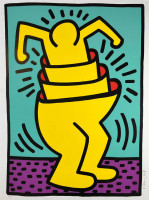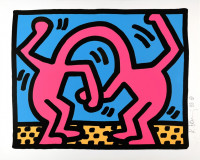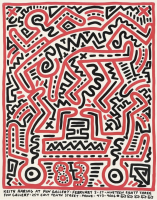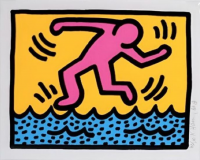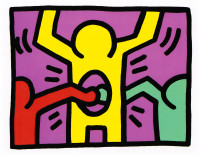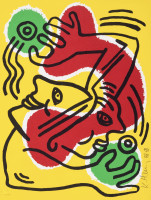
Details
Artist
Styles
Screenprint on wove paper - Signed, numbered, and dated in pencil along right edge; printer's chop mark, lower left - Printed by Durham Press, Durham - LITERATURE: Littmann, p. 178 // Keith Haring's Untitled (Plate 6) from The Blueprint Drawings (1990) is a screen-print that showcases his signature style of bold black lines and stylized human figures. This limited edition piece, created in collaboration with Durham Press, features a sequence of six comic-like panels with dynamic, energetic figures engaged in various activities. The central panel displays two dancing figures, surrounded by radiating lines, a recurring motif in Haring's work symbolizing unity and movement. The surrounding panels illustrate different scenarios, including figures interacting, running, and climbing stairs, presenting a sense of motion and life. The juxtaposition of the panels creates a visual rhythm, inviting the viewer to interpret the narrative flow. Signed, numbered, and dated along the edge, this piece embodies Haring’s approach to art as a means of conveying social and emotional themes through accessible, engaging imagery.
Untitled (Plate 6) from The Blueprint Drawings, 1990
form
Medium
Size
108 x 137.2 cm
- Inches
- Centimeters
Edition
Price
Details
Artist
Styles
Screenprint on wove paper - Signed, numbered, and dated in pencil along right edge; printer's chop mark, lower left - Printed by Durham Press, Durham - LITERATURE: Littmann, p. 178 // Keith Haring's Untitled (Plate 6) from The Blueprint Drawings (1990) is a screen-print that showcases his signature style of bold black lines and stylized human figures. This limited edition piece, created in collaboration with Durham Press, features a sequence of six comic-like panels with dynamic, energetic figures engaged in various activities. The central panel displays two dancing figures, surrounded by radiating lines, a recurring motif in Haring's work symbolizing unity and movement. The surrounding panels illustrate different scenarios, including figures interacting, running, and climbing stairs, presenting a sense of motion and life. The juxtaposition of the panels creates a visual rhythm, inviting the viewer to interpret the narrative flow. Signed, numbered, and dated along the edge, this piece embodies Haring’s approach to art as a means of conveying social and emotional themes through accessible, engaging imagery.
- Recently Added
- Price (low-high )
- Price (high-low )
- Year (low-high )
- Year (high-low )
Keith Haring
Untitled (Plate 16) From The Blueprint Drawings, 1990
Limited Edition Print
Screen-print
USD 35,000 - 45,000
Keith Haring
Untitled (Plate 17) From The Blueprint Drawings, 1990
Limited Edition Print
Screen-print
USD 35,000 - 45,000
Keith Haring
Three Lithographs: One Plate, 1985
Limited Edition Print
Lithograph
USD 30,000 - 40,000
Keith Haring
Poster For Nuclear Disarmament, 1982
Limited Edition Print
Offset Print
Inquire For Price
Keith Haring
Untitled (w/ Sean Kalish) - Set, 1989
Limited Edition Print
Etching
USD 35,000 - 45,000
Keith Haring
New Year's Invitation '88 (Nude) (TP), 1988
Limited Edition Print
Screen-print
USD 8,500
Keith Haring
White Icons (C) - Winged Angel, 1990
Limited Edition Print
Embossing
USD 15,000 - 20,000
Keith Haring
Untitled 1 (from Free South Africa), 1985
Limited Edition Print
Lithograph
Inquire For Price
Keith Haring
Untitled (Free South Africa), 1985
Limited Edition Print
Lithograph
USD 90,000 - 100,000
Keith Haring
White Icons (A) - Radiant Baby, 1990
Limited Edition Print
Embossing
USD 20,000 - 25,000
Keith Haring
Untitled - Scissors (from Pop Shop III), 1989
Limited Edition Print
Screen-print
Currently Not Available
Keith Haring
Untitled (Man On Dolphin), 1987
Limited Edition Print
Lithograph
Currently Not Available
What is Street art?
Street Art is artwork created and executed in public spaces, outside of traditional art venues. It gained popularity during the 1980s graffiti art boom and has since evolved into various forms and styles. Common forms of Street Art include pop-up art, sticker art, stencil graffiti, and street installations or sculptures. Terms like guerrilla art, neo-graffiti, post-graffiti, and urban art are often used interchangeably to describe this genre, which challenges conventional ideas about where and how art should be displayed.



